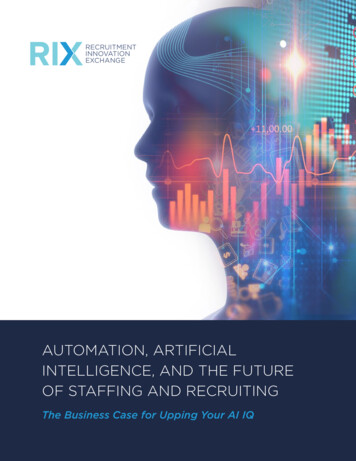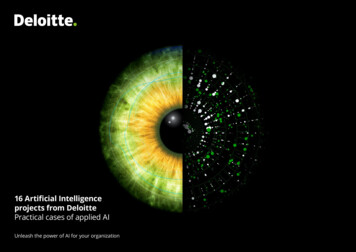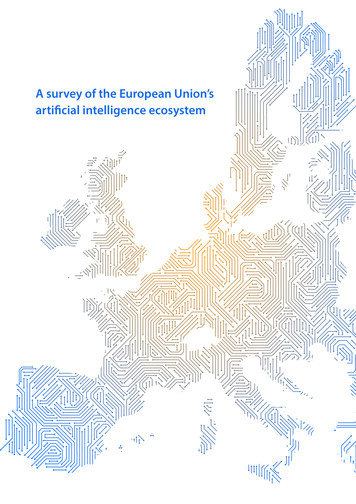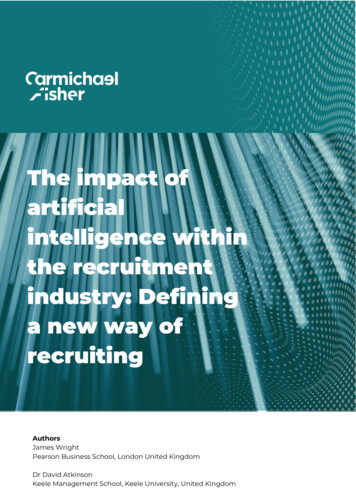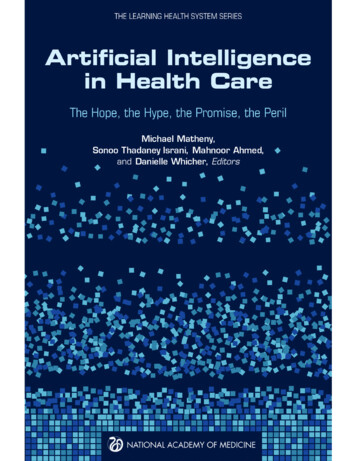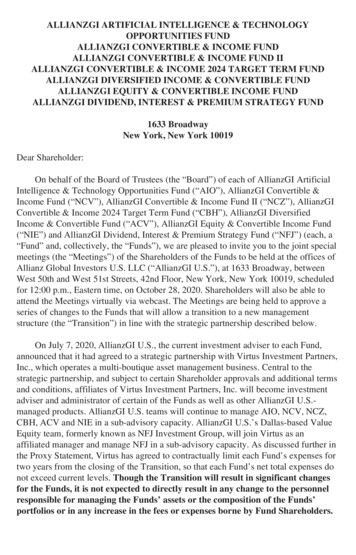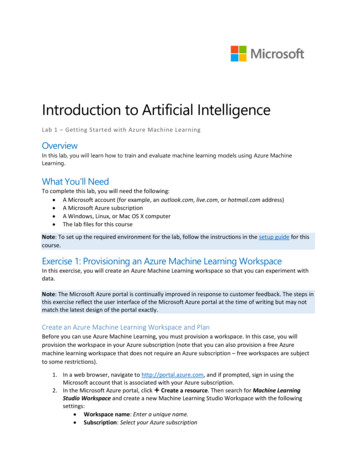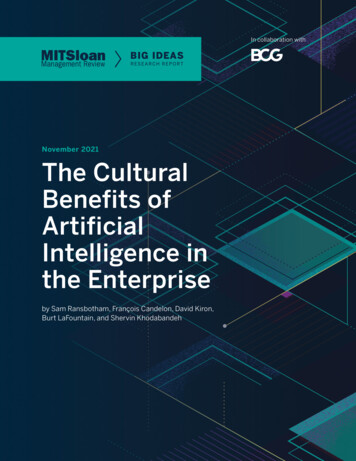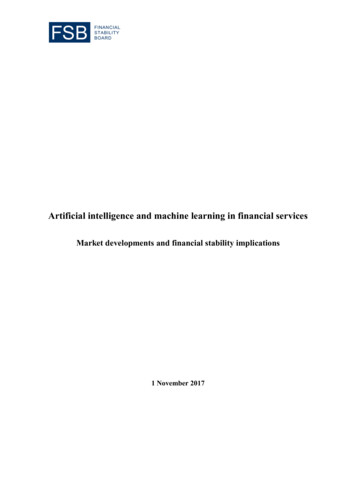
Transcription
Artificial intelligence and machine learning in financial servicesMarket developments and financial stability implications1 November 2017
The Financial Stability Board (FSB) is established to coordinate at the international level thework of national financial authorities and international standard-setting bodies in order todevelop and promote the implementation of effective regulatory, supervisory and otherfinancial sector policies. Its mandate is set out in the FSB Charter, which governs thepolicymaking and related activities of the FSB. These activities, including any decisionsreached in their context, shall not be binding or give rise to any legal rights or obligations underthe FSB’s Articles of Association.Contacting the Financial Stability BoardSign up for e-mail alerts: www.fsb.org/emailalertFollow the FSB on Twitter: @FinStbBoardE-mail the FSB at: fsb@fsb.orgCopyright 2017 Financial Stability Board. Please refer to: http://www.fsb.org/terms conditions
ContentsPageExecutive Summary . 1Introduction . 31.Background and definitions . 32.Drivers . 73.Selected use cases . 103.1Customer-focused uses: credit scoring, insurance and client-facing chatbots . 113.1.1Credit scoring applications. 123.1.2Use for pricing, marketing and managing insurance policies . 133.1.3Client-facing chatbots . 143.2Operations-focused uses . 153.2.1Capital optimisation use case . 153.2.2Model risk management (back-testing and model validation) and stress testing . 163.2.3Market impact analysis (modelling of trading out of big positions) . 173.3Trading and portfolio management . 183.3.1AI and machine learning in trading execution . 183.3.2Scope for the use of AI and machine learning in portfolio management . 183.4AI and machine learning in regulatory compliance and supervision . 193.4.1RegTech: applications by financial institutions for regulatory compliance . 203.4.2Uses for macroprudential surveillance and data quality assurance . 213.4.3SupTech: uses and potential uses by central banks and prudential authorities . 213.4.4Uses by market regulators for surveillance and fraud detection . 234.Micro-financial analysis . 244.1Possible effects of AI and machine learning on financial markets . 244.2Possible effects of AI and machine learning on financial institutions . 254.3Possible effects of AI and machine learning on consumers and investors . 274.4Current regulatory considerations regarding the use of AI and machine learning . 285.Macro-financial analysis . 295.1Market concentration and systemic importance of institutions . 295.2Potential Market Vulnerabilities . 305.3Networks and interconnectedness . 315.4Other implications of AI and machine learning applications . 316.Conclusions and implications for financial stability . 32iii
Glossary. 35Annex A: Legal issues around AI and machine learning . 37Annex B: AI ethics . 39Annex C: Drafting team members . 40iv
Executive SummaryArtificial intelligence (AI) and machine learning are being rapidly adopted for a range ofapplications in the financial services industry. As such, it is important to begin considering thefinancial stability implications of such uses. Because uses of this technology in finance are in anascent and rapidly evolving phase, and data on usage are largely unavailable, any analysismust be necessarily preliminary, and developments in this area should be monitored closely.Many applications, or “use cases”, of AI and machine learning already exist. The adoption ofthese use cases has been driven by both supply factors, such as technological advances and theavailability of financial sector data and infrastructure, and by demand factors, such asprofitability needs, competition with other firms, and the demands of financial regulation. Someof the current and potential use cases of AI and machine learning include:-Financial institutions and vendors are using AI and machine learning methods to assesscredit quality, to price and market insurance contracts, and to automate clientinteraction.-Institutions are optimising scarce capital with AI and machine learning techniques, aswell as back-testing models and analysing the market impact of trading large positions.-Hedge funds, broker-dealers, and other firms are using AI and machine learning to findsignals for higher (and uncorrelated) returns and optimise trading execution.-Both public and private sector institutions may use these technologies for regulatorycompliance, surveillance, data quality assessment, and fraud detection.With the FSB FinTech framework, 1 our analysis reveals a number of potential benefits andrisks for financial stability that should be monitored as the technology is adopted in the comingyears and as more data becomes available. In some cases, these observations are also containedin the FSB report on regulatory and supervisory issues around FinTech. 2 They are:-The more efficient processing of information, for example in credit decisions, financialmarkets, insurance contracts, and customer interaction, may contribute to a moreefficient financial system. The RegTech and SupTech applications of AI and machinelearning can help improve regulatory compliance and increase supervisoryeffectiveness.-At the same time, network effects and scalability of new technologies may in the futuregive rise to third-party dependencies. This could in turn lead to the emergence of newsystemically important players that could fall outside the regulatory perimeter.-Applications of AI and machine learning could result in new and unexpected forms ofinterconnectedness between financial markets and institutions, for instance based on theuse by various institutions of previously unrelated data sources.1FSB (2016), “Fintech: Describing the Landscape and a Framework for Analysis,” March [unpublished].2FSB (2017), “Financial Stability Implications from FinTech, Supervisory and Regulatory Issues that Merit AuthoritiesAttention,” June.1
-The lack of interpretability or “auditability” of AI and machine learning methods couldbecome a macro-level risk. Similarly, a widespread use of opaque models may result inunintended consequences.-As with any new product or service, there are important issues around appropriate riskmanagement and oversight. It will be important to assess uses of AI and machinelearning in view of their risks, including adherence to relevant protocols on data privacy,conduct risks, and cybersecurity. Adequate testing and ‘training’ of tools with unbiaseddata and feedback mechanisms is important to ensure applications do what they areintended to do.Overall, AI and machine learning applications show substantial promise if their specific risksare properly managed. The concluding section gives preliminary thoughts on governance anddevelopment of models, as well as auditability by institutions and supervisors.2
IntroductionThis report analyses possible financial stability implications of the use of artificial intelligence(AI) and machine learning in financial services. It was drafted by a team of experts from theFSB Financial Innovation Network (FIN). The report draws on discussions with firms; 3academic research; public and private sector reports; and ongoing work at FSB memberinstitutions.4 The report analyses potential financial stability implications of the growing use ofAI by financial institutions. Given the relative novelty of many applications, and the paucity ofdata on adoption, it is necessarily a horizon-scanning piece.The report is structured as follows. In section 1, the key concepts of the report are defined, andsome background is given on the development of AI and machine learning for financialapplications. Section 2 describes supply and demand factors driving the adoption of thesetechniques in financial services. Section 3 describes four sets of use cases: (i) customer-focusedapplications; (ii) operations-focused uses; (iii) trading and portfolio management; and (iv)regulatory compliance and supervision. Section 4 contains a micro-analysis of the effects ofadoption on financial markets, institutions and consumers. Section 5 gives a macro-analysis ofeffects on the financial system. Finally, section 6 concludes with an assessment of implicationsfor financial stability.1.Background and definitionsResearchers in computer science and statistics have developed advanced techniques to obtaininsights from large disparate data sets. Data may be of different types, from different sources,and of different quality (structured and unstructured data). These techniques can leverage theability of computers to perform tasks, such as recognising images and processing naturallanguages, by learning from experience. The application of computational tools to address taskstraditionally requiring human sophistication is broadly termed ‘artificial intelligence’ (AI). Asa field, AI has existed for many years. However, recent increases in computing power coupledwith increases in the availability and quantity of data have resulted in a resurgence of interestin potential applications of artificial intelligence. 5 These applications are already being used todiagnose diseases, translate languages, and drive cars; and they are increasingly being used inthe financial sector as well.3FIN held two workshops on this topic. The first workshop was held on 4 April 2017 in San Francisco. The second workshopwas held on 27 June 2017 in Basel. The participants at these workshops included representatives from 7 financialinstitutions, six artificial intelligence firms, three large tech firms and two industry organisations from North America,Europe and Asia. In addition, drafting team members and the FSB secretariat conducted bilateral conversations withrelevant private sector contacts across a range of jurisdictions.4The report draws on some examples from specific private firms involved in FinTech. These examples are not exhaustiveand do not constitute an endorsement by the FSB for any firm, product or service. Similarly, they do not imply anyconclusion about the status of any product or service described under applicable law. Rather, such examples are includedfor purposes of illustration of new and emerging business models in the markets studied.5Various financial regulatory authorities have defined the big data phenomenon as a confluence of factors, including theubiquitous collection of data from a variety of sources, the plummeting cost of data storage and powerful capacity to analysedata. See, e.g., U.S. Federal Trade Commission Report, January (2016,), “Big Data: A tool for Inclusion or Exclusion?”January, p. 1; EBA, EIOPA and ESMA (2016), “European Joint Committee Discussion Paper on the Use of Big Data byFinancial Institutions,” JC 2016 86, p. 7.3
There are many terms that are used in describing this field, so some definitions are neededbefore proceeding. ‘Big data’ is a term for which there is no single, consistent definition, butthe term is used broadly to describe the storage and analysis of large and/or complicated datasets using a variety of techniques including AI. 6 Analysis of such large and complicated datasetsis often called ‘big data analytics.’ A key feature of the complexity relevant in big data setsanalytics often relates to the amount of unstructured or semi-structured data contained in thedatasets.This report defines AI as the theory and development of computer systems able to perform tasksthat traditionally have required human intelligence. AI is a broad field, of which ‘machinelearning’ is a sub-category. 7 Machine learning may be defined as a method of designing asequence of actions to solve a problem, known as algorithms, 8 which optimise automaticallythrough experience and with limited or no human intervention. 9 These techniques can be usedto find patterns in large amounts of data (big data analytics) from increasingly diverse andinnovative sources. Figure 1 gives an overview.Figure 1: A schematic view of AI, machine learning and big data analyticsMachinelearningDeep learningArtificial intelligenceSupervised learningReinforcement learningBig dataanalyticsUnsupervised learningMany machine learning tools build on statistical methods that are familiar to most researchers.These include extending linear regression models to deal with potentially millions of inputs, orusing statistical techniques to summarise a large dataset for easy visualisation. Yet machine6Jonathan Stuart Ward and Adam Barker (2013), “Undefined By Data: A Survey of Big Data Definitions” Cornell University,arXiv:1309.5821.7Examples of AI applications that are not machine learning include the computer science fields of ontology management,or the formal naming and defining of terms and relationships by computers, as well as inductive and deductive logic andknowledge representation. In this report, for completeness, we often refer to “AI and machine learning,” with theunderstanding that many of the important recent advances are in the machine learning space.8An algorithm may be defined as a set of steps to be performed or rules to be followed to solve a mathematical problem.More recently, the term has been adopted to refer to a process to be followed, often by a computer.9Arthur Samuel (1959), “Some Studies in Machine Learning Using the Game of Checkers,” IBM Journal: 211-229; TomMitchell (1997), Machine Learning, New York: McGraw Hill; Michael Jordan and Tom Mitchell (2015), “Machinelearning: Trends, perspectives, and prospects,” Science 349(6245): 255-260. Samuel defined machine learning as the “fieldof study that gives computers the ability to learn without being explicitly programmed,” while Mitchell defines it as the“the question of how to build computers that improve automatically through experience.”4
learning frameworks are inherently more flexible; patterns detected by machine learningalgorithms are not constrained to the linear relationships that tend to dominate economic andfinancial analysis. In general, machine learning deals with (automated) optimisation, prediction,and categorisation, not with causal inference. 10 In other words, classifying whether the debt ofa company will be investment grade or high yield one year from now could be done withmachine learning. However, determining what factors have driven the level of bond yieldswould likely not be done using machine learning.There are several categories of machine learning algorithms. These categories vary accordingto the level of human intervention required in labelling the data: In ‘supervised learning’, the algorithm is fed a set of ‘training’ data that contains labelson some portion of the observations. For instance, a data set of transactions may containlabels on some data points identifying those that are fraudulent and those that are notfraudulent. The algorithm will ‘learn’ a general rule of classification that it will use topredict the labels for the remaining observations in the data set. ‘Unsupervised learning’ refers to situations where the data provided to the algorithmdoes not contain labels. The algorithm is asked to detect patterns in the data byidentifying clusters of observations that depend on similar underlying characteristics.For example, an unsupervised machine learning algorithm could be set up to look forsecurities that have characteristics similar to an illiquid security that is hard to price. Ifit finds an appropriate cluster for the illiquid security, pricing of other securities in thecluster can be used to help price the illiquid security. ‘Reinforcement learning’ falls in between supervised and unsupervised learning. In thiscase, the algorithm is fed an unlabelled set of data, chooses an action for each data point,and receives feedback (perhaps from a human) that helps the algorithm learn. Forinstance, reinforcement learning can be used in robotics, game theory, and self-drivingcars. 11 ‘Deep learning’ is a form of machine learning that uses algorithms that work in ‘layers’inspired by the structure and function of the brain. Deep learning algorithms, whosestructure are called artificial neural networks, can be used for supervised, unsupervised,or reinforcement learning.Recently, deep learning has led to remarkable results in diverse fields, such as imagerecognition and natural language processing (NLP). Deep learning algorithms are capable ofdiscovering generalisable concepts, such as encoding the concept of a ‘car’ from a series ofimages. An investor might deploy an algorithm that recognises cars to count the number of carsin a retail parking lot from a satellite image in order to infer a likely store sales figure for aparticular period. NLP allows computers to ‘read’ and produce written text or, when combined10Here, prediction is understood as identifying something as likely before the event based on experience. Causal inferenceand forecasting are done from a scientific perspective on the basis of analysis of the past.11This categorisation of machine learning algorithms is taken from Kolanovic, Marko and Rajesh Krishnamachari (2017),“Big Data and AI Strategies: Machine Learning and Alternative Data Approach to Investing,” JP Morgan, May; and InternetSociety (2017), “Artificial Intelligence and Machine Learning: Policy Paper,” Internet Society White Paper, April.5
with voice recognition, to read and produce spoken language. This allows firms to automatefinancial service functions previously requiring manual intervention.Machine learning can be applied to different types of problems, such as classification orregression analysis. Classification algorithms, which are far more frequently deployed inpractice, group observations into a finite number of categories. Classification algorithms areprobability-based, meaning that the outcome is the category for which it finds the highestprobability that it belongs to. An example might be to automatically read a sell-side report andlabel it as ‘bullish’ or ‘bearish’ with some probability, or estimate an unrated company’s initialcredit rating. Regression algorithms, in contrast, estimate the outcome of problems that have aninfinite number of solutions (continuous set of possible outcomes). This outcome can beaccompanied with a confidence interval. Regression algorithms can be used for the pricing ofoptions. Regression algorithms can also be used as one intermediate step of classificationalgorithm.It is important to note what machine learning cannot do, such as determining causality.Generally speaking, machine learning algorithms are used to identify patterns that are correlatedwith other events or patterns. The patterns that machine learning identifies are merelycorrelations, some of which are unrecognisable to the human eye. However, AI and machinelearning applications are being used increasingly by economists and others to help understandcomplex relationships, along with other tools and domain expertise.Many machine learning techniques are hardly new. Indeed, neural networks, the base conceptfor deep learning, were first developed in the 1960s. 12 However after an initial burst ofexcitement, machine learning and AI failed to live up to their promises and funding dissipatedfor over a decade, in part because of the lack of sufficient computing power and data. Therewas renewed funding and interest in applications in the 1980’s, during which many of theresearch concepts were developed for later breakthroughs. 13By 2011 and 2012, driven by the vast increase in the computational power of moderncomputers, machine learning algorithms, especially deep learning algorithms, began toconsistently win image, text, and speech recognition contests. Noticing this trend, major techcompanies began to acquire deep learning start-ups and rapidly accelerate deep learningresearch. 14 Also new is the scale of collection of big data, for example the ability to capturedata on the scale of every single credit card transaction or every word on the web, and even‘mouse’ hovers over websites. Other advances have also helped, such as increasedinterconnectedness of information technology resources with cloud computing architecture,with which big data can now be organised and analysed. Using data sets of this size andcomplexity and with the increase in computing power, machine learning algorithms results haveimproved, some of which are highlighted in the sections that follow. This has also spurred large12The ‘K-Nearest-Neighbour’ algorithm, which is the simple, intuitive machine learning algorithm taught at the start of manyundergraduate Computer Science classes, was proposed in its modern form in 1967. See Thomas Cover and Peter Hart(1967), “Nearest Neighbor Pattern Classification,” IEEE transactions on information theory. 13.1: 21-27.13See Luke Dormehl (2016), Thinking Machines: The Quest for Artificial Intelligence--and Where It's Taking Us Next,London: Penguin Books.14Tim Dettmers (2015), “Deep Learning in a Nutshell: History and Training,” Parallel Forall, December. Accessed on May30, 2017. Web. arning-nutshell-history-training/6
investments in AI start-ups. The World Economic Forum reported that global investment in AIstart-ups rose from 282 million in 2011, to 2.4 billion in 2015. 15 The number of merger andacquisition (M&A) deals in AI has also accelerated over this period (figure 2).Figure 2: Global artificial intelligence merger and acquisition activity, 2012-2017Source: CB Insights (2017), “The Race For AI: Google, Baidu, Intel, Apple In A Rush To Grab Artificial Intelligence Startups,”Research Brief, July.Many applications tend more toward ‘augmented intelligence,’ or an augmentation of humancapabilities, rather than a replacement of humans. Even as advancements in AI and machinelearning continue, including in the area of deep learning, most industries are not attempting tofully replicate human intelligence. As noted by one industry observer “ a human in the loopis essential: we are, unlike machines, able to take into account context and use generalknowledge to put AI-drawn conclusions into perspective.” 162.DriversA variety of factors that have contributed to the growing use of FinTech generally have alsospurred adoption of AI and machine learning in financial services. 17 On the supply side,financial market participants have benefitted from the availability of AI and machine learning15See Slaughter and May and ASI Data Science (2017), “Superhuman Resources: Responsible deployment of AI in business,”Joint White Paper, June.16See Finextra and Intel (2017), “The Next Big Wave: How Financial Institutions Can Stay Ahead of the AI Revolution,”May.17See FSB FinTech Issues Group (2017), p.10. AI and machine learning are also being adopted widely in sectors such ashealth care, manufacturing, marketing, and many other areas.7
tools developed for applications in other fields. These include availability of computing powerowing to faster processor speeds, lower hardware costs, and better access to computing powervia cloud services. 18 Similarly, there is cheaper storage, parsing, and analysis of data throughthe availability of targeted databases, software, and algorithms. There has also been a rapidgrowth of datasets for learning and prediction owing to increased digitisation and the adoptionof web-based services. 19 The declining cost of data storage and estimates of the volume ofglobal data sets are shown in figure 3.Figure 3: Costs of storage and global data availability, 2009-2017Source: Reinsel, Gantz and Rydning (2017); Klein (2017). One zettabyte is equal to one billion terabytes.The same tools driving advances in machine learning in search engines and self-driving cars,can be adopted in the financial sector. For example, entity recognition tools that enable searchengines to understand when a user is referring to Ford Motor Company, rather than fording ariver, are now used to quickly identify news or social media chatter relevant to publicly tradedfirms. As more firms adopt these tools, the financial incentives to access new or additional dataand to develop faster and more accurate AI and machine learning tools may increase. In turn,such adoption and development of tools may affect incentives for yet other firms.A variety of technological developments in the financial sector have contributed to the creationof infrastructure and data sets. The proliferation of electronic trading platforms has beenaccompanied by an increase in the availability of high quality market data in structuredformats. 20 In some countries, such as the United States, market regulators allow publicly tradedfirms to use social media for public announcements. In addition to making digitised financial18See IOSCO (2017), “Research Report on Financial Technologies (Fintech),” February, p. 6 on growth of computing power.19Institute of International Finance (2017), “Deploying RegTech Against Financial Crime,” Report of the IIF RegTechWorking Group, March; David Reinsel, John Gantz and John Rydning (2017), “Data Age 2025: The Evolution of Data toLife-Critical,” IDC White Paper, April; Andy Klein (2017), “Hard Drive Cost Per Gigabyte,” Backblaze, July.20See IOSCO (2017), p. 41 for description of APIs and FIX protocols to assist in price discovery and market liquidity incorporate bond markets.8
data available for machine learning, the computerisation of markets has made it possible for AIalgorithms to interact directly with markets, putting in real-time complex buy and sell ordersbased on sophisticated decision-making, in many cases with minimal human intervention.Meanwhile, retail credit scoring systems have become more common since the 1980s, 21 andnews has become machine readable since the 1990s. With the growth of data in financialmarkets as well as datasets – such as online search trends, viewership patterns and social mediathat contain financial information about markets and consumers – there are even more datasources that can be explored and mined in the financial sector.On the demand side, financial institutions have incentives to use AI and machine learning forbusiness needs. Opportunities for cost reduction, risk management gains, and productivityimprovements have encouraged adoption, as they all can contribute to greater profitability. Ina recent study, industry sources described priorities for using AI and machine learning asfollows: optimising processes on behalf of clients; working to create interactions betweensystems and staff applying AI to enhance decision-making; and developing new products andservices to offer to clients. 22 In many cases these factors may also drive ‘arms races’ in whichmarket participants increasingly find it necessary to keep up with their competitors’ adoptionof AI and machine learning, including for reputational reasons (hype).Figure 4: Supply and demand factors of financial adoption of AI and machine learningTechnologyFinancialsector factorsProfitabilityCompetitionRegulationPotential for“Arms race”Prudentialin computingAvailability ofcost reduction,with otherregulations,power, datainfrastructurerevenue gains,financialdata reporting,availability,and data toimproved riskinstitutionsbest execution,algorithms,apply newmanagementand firmsAML, etc.costs, etc.techniquesImprovementsSupply factorsDemand factorsThere is also demand due to regulatory compliance. 23 New regulations have increased the needfor efficient regulatory compliance, which has pushed banks to automate 24 and adopt newanalytical tools that can include use of AI and machine learning. Financial institutions areseeking cost effective means of complying with regulatory requirements, such as prudential21Examples include the FICO score in the US and Canada, Schufa scoring in Germany and firm-specific scores in Japan.22Finextra and Intel (2017).23From the perspective of technology companies offering
Figure 1: A schematic view of AI, machine learning and big data analytics . Many machine learning tools build on statistical methods that are familiar to most researchers. These include extending linear regression models to deal with potentially millions of inputs, or using statistical techni

